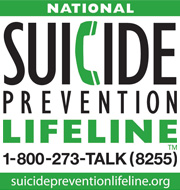
Know the Signs
According to 2014 data, suicide is the second leading cause of death among U.S. teens. People who are suicidal often do or say things that are signals they may be thinking about committing suicide.
The National Alliance on Mental Illness (NAMI) shares common warning signs to watch for:
- Threats or comments about killing themselves. This may begin with seemingly harmless comments like, “I wish I wasn’t here”
- Increased alcohol or drug use
- Aggressive behavior
- Social withdrawal from friends, family and community
- Dramatic mood swings
- Talking, writing, or thinking about death
- Impulsive or reckless behavior
- Putting their affairs in order or giving away possessions
- Saying goodbye to friends and family
- Mood shifts from despair to calm
- Planning, possibly by looking around, to buy, steal or borrow the tools needed to commit suicide, such as a firearm or prescription medication.
Knowing what to look for is the first step in helping someone who may be considering suicide. If you sense that something is wrong, trust your instincts.
Find the Words
Start the Conversation:
If you think a friend or family member is considering suicide, you might be afraid to bring up the subject. Don’t be afraid! Talking openly about suicidal thoughts and feelings can save a life. Talking about suicide won’t give the person ideas about death. The opposite is true — bringing up the subject of suicide and discussing it openly is one of the most helpful things you can do.
Tell the person you are worried about them. Mention the warning signs you have noticed. Be sure to have suicide crisis resources on hand.
Ask about Suicide:
Ask the person if they are thinking about suicide. If they say they are feeling hopeless or considering suicide, take them seriously.
Listen:
Express concern and reassure the person. Listen with empathy and provide support. Someone who is experiencing emotional pain or suicidal thoughts can feel isolated, even with family and friends around.
Create a Safety Plan:
A safety plan can help guide a person through a crisis and help keep them safe. A safety plan is a written list of coping strategies and sources of support for people who are at high risk for suicide. The strategies found in a customized safety plan can be used before or during a suicidal crisis.
Make sure the person you care about keeps the plan easily accessible in case they have thoughts of hurting themselves. Ask the person if they have access to any lethal means (weapons, medications, etc.) and help remove them from the vicinity.
For information and a template on how to create a safety plan, visit www.suicidepreventionlifeline.org/help-yourself or my3app.org/safety-planning.
Get Help:
Provide the person with the resources you have come prepared with. Call the National Suicide Prevention Lifeline anytime at 1-800-273-8255.
If you feel the situation is critical, take the person to a nearby emergency room or walk-in psychiatric crisis clinic, or call 9-1-1.
HOTLINES AND WHERE TO FIND HELP
National Suicide Prevention Lifeline — 9-8-8
You can also chat online by visiting 988lifeline.org and clicking the Chat button.
The Lifeline is free, confidential and always available.
Trevor Project — 1-866-488-7386
The Trevor Project provides crisis intervention and suicide prevention for LGBTQ youth and is always available.
Crisis Text Line — Text HELLO to 741741
The Crisis Text Line is free 24/7 and confidential.
Legislation
California State PTA supported AB 2246 (O’Donnell 2016) which mandated that the governing board of any local educational agency that services pupils in grades seven to twelve adopt a policy on pupil suicide prevention, intervention, and post-vention. The bill was signed into law by Governor Brown and went into effect at the beginning of the 2017-2018 school year. The law specifically addresses the needs of high-risk groups, including suicide awareness and prevention training for teachers.
The California Department of Education has developed a model policy to guide district’s efforts in developing an appropriate policy in their school district. View the Model Youth Suicide Prevention Policy at www.cde.ca.gov/ls/cg/mh/index.asp.
ADDITIONAL RESOURCES
- Suicide Prevention Webinar from VP for Health & Community Concerns and suicideispreventable.org
- Suicide is Preventable — www.suicideispreventable.org
- Suicide Prevention Lifeline — www.suicidepreventionlifeline.org
- Directing Change Slides
- My3 App — my3app.org
- Society for the Prevention of Teen Suicide — www.sptsusa.org/parents
- National Association of School Psychologists — www.nasponline.org
- Substance Abuse and Mental Health Services Administration — Suicide Prevention: Facts for Parents
- HelpGuide.org — www.helpguide.org
- The Jason Foundation — www.jasonfoundation.com/youth-suicide
- Model Youth Suicide Prevention Policy for Schools
- The S Word — www.theswordmovie.com
- American Psychiatric Association — www.psychiatry.org/patients-families/suicide-prevention
- American Psychology Association — 7 Essential Steps Parents Can Take to Prevent Teen Suicide
- Article from The Conversation — With Teen Mental Health Deteriorating Over Five Years, There’s a Likely Culprit
- Article from Kaplan University – Our Nation’s Young and Suicide
- Directing Change – Program and Film Contest
- AB 2246 Resources and Tools
- Learn more about Mental Health.